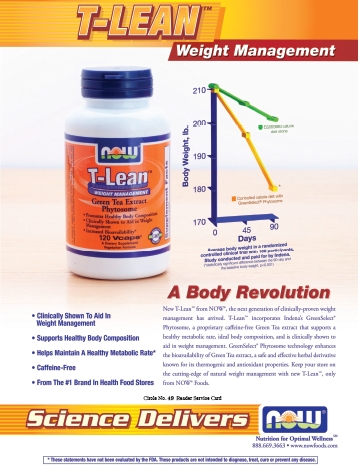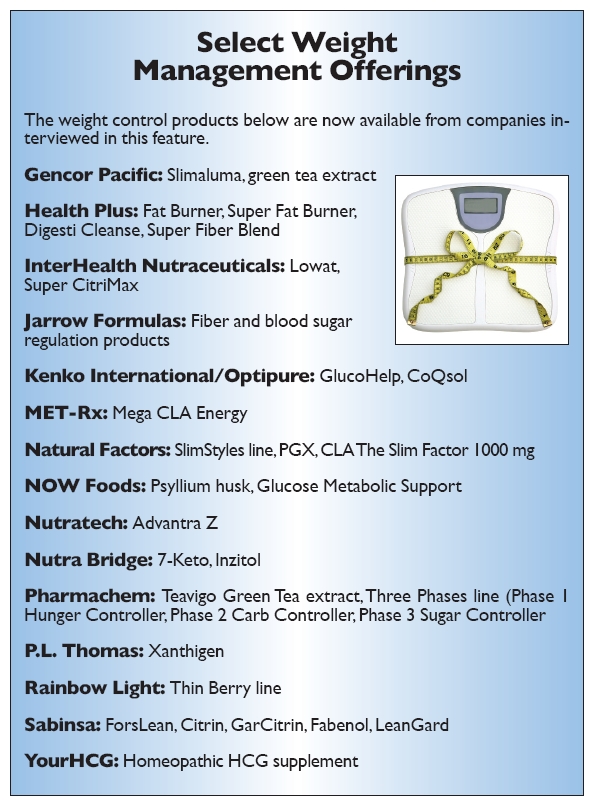The subject of weight management does not only merit the concern of those looking to shed significant pounds. The term “management” applies beyond the effort undertaken by millions to achieve a healthier body composition. It also implies maintenance, and the struggle we all go through to retain that healthy state. The supplements available to aid in these efforts (rather than to magically or immediately secure results) are diverse. “Products may claim to be fat blockers, lipotropics or fat busters, thermogenics or energy modifiers, to change carbohydrate metabolism, offer water elimination or provide the feeling of satiety or fullness,” says N. Kalyanam, Ph.D., president of New Jersey research and development for Sabinsa Corp., East Windsor, NJ.
The reasons for attaining a healthy body composition, an ideal that is not identical for each individual, are immense and well-recognized. However, the causes and health implications of obesity may be even more complex than most are aware of, as we will find out. This article will also air expert views on topics like weight loss supplements for young people, and preserving the legitimacy of the weight management products segment.
Tried and True
Distinctive views on the mechanisms behind weight gain and loss are foundational for the way product development teams approach the issue. Mitch Skop, senior director of new product development at Pharmachem Laboratories Inc., Kearny, NJ, explains this dynamic in the case of his company. He says that because the three primary diet-related reasons people gain weight, in their view, are over-eating, excessive carbohydrate consumption and excessive sugar consumption, the company developed what it calls the Three Phases of Weight Control.
This plan consists of three ingredients that cater to these three problem areas. The first ingredient, a fluid emulsion derived from purified palm and oat oils, tackles hunger control. The second ingredient is a white bean extract designed to slow the rate of carbohydrate absorption, and the third is a combination of L-arabinose and a patented chromium compound, designed to regulate sugar absorption and insulin levels.
The strategy behind an approach like this one is to achieve more comprehensive results by addressing several weight loss factors at once. Consumers should talk to their doctors before beginning any supplements regimen designed to help manage weight. On the other hand, individual strategies for addressing weight through supplementation, even when used in isolation, will often have multiple areas of effect. Some products, for instance, are designed to both aid metabolism and increase the thermic effect of food, a concept which will be explained later.
Apart from these approaches to weight loss, some supplements aim to increase the efficiency and functionality of fat metabolism, or are designed to improve the way the liver stores and releases fat. The next section delves into these areas, all of which are thought to influence the size of our waistlines.
Manufacturers, proud as they are of the efficacy and legitimacy of their products, never want retailers to lose sight of one fact: supplements only stand a chance of working in conjunction with proper diet and exercise. No weight management aid can truly take off unless the consumer understands that success comes from lifestyle choices, and never exclusively from the shelves of retailers. “Consumers must make the mental and emotional commitment to a healthy longevity by objectively assessing their lifestyles,” says Sunil Kohli, COO, Health Plus Inc., Chino, CA.
Retailers are positioned to help people begin their own weight loss success stories. They get the double reward of both a loyal, returning customer and gratification at helping a client achieve their goal. “Once the commitment is made, retailers can capitalize on this by marketing themselves as a personalized healthy lifestyle center. The truth is, many consumers want to do this, but are totally lost, overwhelmed or confused. Get them into the store to ‘show and tell,’ and retailers will thus cultivate a loyal base,” Kohli says.
Targeted Approaches
Satiety. The accumulation of body fat, in simple terms, is the result of ingesting and storing more fat than the body is using for energy purposes. The first line of defense against unhealthy weight gain, then, is clearly to limit the intake of food. This does not mean that starvation diets are the answer. It is well-established that this will slow down the metabolism, and will only result in temporary, unhealthy weight loss. “Really fast weight loss requires caloric restriction in some form, but unless handled very carefully, this leads to a greater proportionate loss of lean tissue than fat, and to weight rebound,” says Dallas Clouatre, Ph.D., new product development and marketing consultant for Jarrow Formulas, Los Angeles, CA.
No, the idea instead is to prevent overeating. This, combined with increased physical activity, is what will bring lasting results, according to R.V. Venkatesh, managing director of the Gencor Pacific Group, Anaheim, CA. Controlling appetite in a healthy way ensures weight is lost and that the loss in maintained without rebound effects. “Hence, supplements with scientific evidence supported by clinical trial for appetite control are the best way to go,” says Venkatesh. The acceptance of this fact has led the supplement industry to turn heavily toward satiety products. If a satiety product can do its job of creating a feeling of fullness before overeating occurs, it will certainly aid dedicated consumers in achieving their weight loss goals.
“Being able to control hunger is a powerful thing. It not only affects weight management, but daily life as well,” says Paul Dijkstra, CEO, InterHealth Nutraceuticals, Benicia, CA. He argues that curbing hunger also frees time and energy to pursue other things, such as exercise. The idea behind some appetite control supplements is to help consumers stay better connected with internal indicators of fullness. “We should learn to recognize when ‘enough is enough’ and for some persons, supplementation can assist in recognizing the body’s cues that the stomach is full,” says Ron Udell, president and CEO, Kenko International, Inc., Los Angeles, CA.
But there is more than one way to skin a cat, or in this case, to make the brain activate its satiety pathways faster. One option on the market is extract of Caralluma fimbriata, a succulent plant used for  centuries in rural India as a “famine food,” which is thought to affect appetite control through the brain. A branded extract (Slimaluma) from Venkatesh’s company is supported by two human clinical studies, an animal study and a cell line study due for publication (see “Caralluma fimbriata Suppresses Appetite” on page 50). These studies, Venkatesh explains, have shown that the ingredient controls hunger, while reducing abdominal adiposity (the presence of fatty tissue) as well (1).
centuries in rural India as a “famine food,” which is thought to affect appetite control through the brain. A branded extract (Slimaluma) from Venkatesh’s company is supported by two human clinical studies, an animal study and a cell line study due for publication (see “Caralluma fimbriata Suppresses Appetite” on page 50). These studies, Venkatesh explains, have shown that the ingredient controls hunger, while reducing abdominal adiposity (the presence of fatty tissue) as well (1).
“[It] reduces hunger and also reduces abdominal adiposity by inhibiting differentiation of adipocytes, leading to a reduction of adipose tissue and fat storage at the waist area,” Venkatesh says. He emphasizes that the major risk factor in obese individuals is abdominal adiposity, as measured by waist circumference. “The abdominal area is where all the endocrine organs of the body are located, and abdominal fat or belly fat affects all endocrine functions,” he says.
The accumulation of fat in these areas can lead to insulin resistance, inflammation and the other risk factors leading to metabolic syndrome, itself a precursor of diabetes and stroke. Venkatesh concludes, “The new slogan for the fight against obesity seems to be, ‘It’s the waist that matters, not the weight.’” Michael Murray, N.D., director of product development, Natural Factors, Everett, WA, concurs, explaining that abdominal obesity is directly associated with high cholesterol, triglycerides and blood pressure. It also leads to dyslipidemia and hypertension, in addition to the other the risk factors provided by Venkatesh.
 Supplements that seek to curb appetite before meals often utilize an old standby, fiber. Rather than through deprivation, the key to losing weight is eliminating excessive hunger, while increasing the level of satisfaction derived from eating food, according to Murray. A tool that may be useful toward that end is a branded proprietary fiber matrix (PolyGlycoPlex, PGX), which is highly soluble. It is able to bind up to 600 times its weight in water, according to Murray. “To put this in perspective, a small, five-gram serving of PGX in a meal replacement formula or on its own produces a volume and viscosity that would be equal to as much as four or five bowls of oat bran,” he says.
Supplements that seek to curb appetite before meals often utilize an old standby, fiber. Rather than through deprivation, the key to losing weight is eliminating excessive hunger, while increasing the level of satisfaction derived from eating food, according to Murray. A tool that may be useful toward that end is a branded proprietary fiber matrix (PolyGlycoPlex, PGX), which is highly soluble. It is able to bind up to 600 times its weight in water, according to Murray. “To put this in perspective, a small, five-gram serving of PGX in a meal replacement formula or on its own produces a volume and viscosity that would be equal to as much as four or five bowls of oat bran,” he says.
Other satiety supplements derive their benefits from different sources of fiber. Psyllium husk also swells when ingested with water, making the individual feel full more quickly. “It provides early satiety or mid-day satiety (the time when snack cravings tend to haunt people)—and the psyllium husk has the added benefit of ensuring smoother, regular bowel function,” says Kohli, who’s company offers psyllium husk as the key ingredient in its colon cleanser.
“If the issue is simply having an excessive appetite for food, then there are multiple options,” claims Neil Levin, nutrition education manager, NOW Foods, Bloomingdale, IL. He suggests another plant called hoodia with similar effects to Carulluma; filling up with fiber and water before and during a meal; and ingesting nutrient-dense foods with substances like omega-3 fatty acids, spirulina or other algaes before or during a meal. Levin also says whole food supplements rich in basic nutrients could do the trick.
Satiety control can indeed be a crucial component of a weight- loss program, and early-onset fullness is one of the main factors influencing the success of calorie-restricted dieting, according to Kohli. “But this is just one tool in the kit. Depending upon how much weight the individual needs to lose, other tools may be needed, such as thermogenics and lipotropics to accelerate fat loss during the length of the exercise program,” he argues.
Lipotropics. All supplements that are considered lipotropics share the aim of increasing the efficiency of fat metabolism. The ingredients brought to bear and the biological functions those ingredients target is what separates lipotropic products from one another. Green tea extracts, for example, contain epigallocatechin gallate (EGCG), which is thought to enhance metabolism, increase fat oxidation and generally aid in weight management, according to Skop. One pilot study, published in the Journal of the American College of Nutrition, saw six overweight male subjects given 300 mg EGCG (branded extract Teavigo from DSM Nutritional Products) per day for two days. “Results suggest that EGCG alone has the potential to increase fat oxidation in men and may contribute to the anti-obesity effects of green tea,” Skop says.
is thought to enhance metabolism, increase fat oxidation and generally aid in weight management, according to Skop. One pilot study, published in the Journal of the American College of Nutrition, saw six overweight male subjects given 300 mg EGCG (branded extract Teavigo from DSM Nutritional Products) per day for two days. “Results suggest that EGCG alone has the potential to increase fat oxidation in men and may contribute to the anti-obesity effects of green tea,” Skop says.
Many other plant extracts and amino acids exhibit lipotropic effects. “We believe that using lipotropics is the safest and most effective way of supporting the body’s ability to use its own fuel—fat cells—for energy,” says Kohli. Three substances that turn up often in lipotropic products are HCA (hydroxycitric acid, from Garcinia cambogia), l-carnitine and chromium picolinate.
HCA is an extract that is linked with appetite control and the accelerated burning of calories. It is thought to increase lipid oxidation, meaning a more efficient metabolism of ingested fat, according to Kalyanam. It may also slow the conversion of fats from carbohydrates into adipose tissue. Unused carbohydrates are stored as glycogen in the liver, and when this storage reaches capacity, a feeling of fullness results, thus curbing the appetite. HCA may also increase the production of glycogen, further suppressing hunger.
 According to Kohli, l-carnitine is an amino acid that has also been shown, in numerous studies, to accelerate the conversion of stored body fat into energy, which increases the efficacy of exercise. Chromium picolinate is an essential trace nutrient, which evidence shows may support the regulation of blood sugar levels, by increasing the effectiveness of insulin at creating energy through glucose metabolism. Additionally, the protein leptin is believed to send signals to the brain, which then initiates the process of breaking down fat into energy. This lipotropic action occurs only when leptin is present at high enough levels in the bloodstream (2).
According to Kohli, l-carnitine is an amino acid that has also been shown, in numerous studies, to accelerate the conversion of stored body fat into energy, which increases the efficacy of exercise. Chromium picolinate is an essential trace nutrient, which evidence shows may support the regulation of blood sugar levels, by increasing the effectiveness of insulin at creating energy through glucose metabolism. Additionally, the protein leptin is believed to send signals to the brain, which then initiates the process of breaking down fat into energy. This lipotropic action occurs only when leptin is present at high enough levels in the bloodstream (2).
Conjugated linoleic acid (CLA) is an interesting proposition for weight loss, in that it may be an effective lipotropic, but researchers aren’t sure why yet. According to Cory Davidson, senior nutrition researcher for MET-Rx, Ronkonkoma, NY, while the actual mechanism of action is still being investigated, some have theorized that CLA may work by adjusting the body’s use of stored energy. “Dietary intake of CLA is predominantly from dairy and beef fat, but is usually much lower than the amounts that can be obtained from dietary supplements,” says Davidson.
Insulin regulation. While weight gain is a well-established precursor to diabetes, many insist that insulin resistance is itself a major contributor to weight gain. Excessive abdominal fat is highly correlated with insulin insensitivity, and this can, in turn, result in the accumulation of more fatty deposits in what constitutes a vicious circle. This common dilemma has led companies in the weight management supplements market to take a serious look at blood sugar control as a means of reducing body mass.
Clouatre explains that insulin is responsible for the feelings of hunger and satiety, the ability to oxidize fat for energy and the thermic effect of food. In  addition, excessive tissue can insulate body heat, causing the body to compensate by switching off the thermic effect, thereby exacerbating the problem. “From these points, it should be clear that unless the insulin response issue and the associated hindrance of fat metabolism are resolved, there cannot be lasting weight loss,” says Clouatre. He says that the effectiveness of weight loss supplements may even be limited if an insulin condition exists and remains unaddressed.
addition, excessive tissue can insulate body heat, causing the body to compensate by switching off the thermic effect, thereby exacerbating the problem. “From these points, it should be clear that unless the insulin response issue and the associated hindrance of fat metabolism are resolved, there cannot be lasting weight loss,” says Clouatre. He says that the effectiveness of weight loss supplements may even be limited if an insulin condition exists and remains unaddressed.
Because of the regulatory tasks insulin must perform, correcting an issue in this area will usually lead to slow, steady weight loss, Clouatre says. “This is especially apparent when carbohydrates are restricted. After several decades of refusals in medical circles even to test the low carbohydrate diet hypothesis, the tide may be turning,” he adds. He cites a recent study that implies cutting out the carbs, or at least greatly reducing their intake, may promote weight loss in those with high serum insulin (3).
In addition to fostering more efficient metabolism, a healthy blood sugar balance can contribute to a lower calorie diet. “When the blood sugar remains stabilized, this may help reduce food cravings significantly,” says Marci Clow, senior director of product research, Rainbow Light Nutritional Systems, Santa Cruz, CA. A branded extract (Svetol from Naturex) of green coffee berry has some recent research backing its ability to help stabilize blood sugar and support weight loss, according to Clow.
Several in vitro studies have shown that chlorogenic acids, a component of coffee, reduce intestinal absorption of glucose and inhibit the enzyme  glucose-6-phosphatase. This combination has the effect of reducing blood glucose, resulting in the breakdown of triglycerides in adipose tissue. After a positive pilot study, a second placebo-controlled, double-blind study conducted on 50 overweight subjects showed an average reduction in weight of 5.7%. This was following 60 days of treatment with two 200-mg capsules of the ingredient per day. Clow notes that the results also showed an increase in the lean-to-fat mass ratio of 4%, which was significantly higher than placebo (4). She also cites the potential of fenugreek, cinnamon and fiber supplements for balancing blood sugar and staving off food cravings.
glucose-6-phosphatase. This combination has the effect of reducing blood glucose, resulting in the breakdown of triglycerides in adipose tissue. After a positive pilot study, a second placebo-controlled, double-blind study conducted on 50 overweight subjects showed an average reduction in weight of 5.7%. This was following 60 days of treatment with two 200-mg capsules of the ingredient per day. Clow notes that the results also showed an increase in the lean-to-fat mass ratio of 4%, which was significantly higher than placebo (4). She also cites the potential of fenugreek, cinnamon and fiber supplements for balancing blood sugar and staving off food cravings.
In summing up the need to tackle any potential insulin problem when managing weight, Clouatre says, “Insulin insensitivity leads to volatile energy levels, excessive hunger, a reduced rate of brain response to food ingestion and a reduced thermic effect of food.”
Thermogenesis. That point about reduced thermic effect directs us to the next common area of focus in this market segment: thermogenics. “There’s no question that thermogenesis is one of the most effective methods of weight management. It’s certainly one of the most studied,” says Bob Green, president of Nutratech, Inc., West Caldwell, NJ. Providing the energy required to metabolize food is one of the roles of fat in the body. If the rate of this conversion can be elevated, the rate at which unhealthy fatty deposits dissipate will rise also. The way to accomplish this is through the dietary intake of substances that require high amounts of energy to metabolize.
CLA is included in combination with caffeine in one product recommended by Davidson. Caffeine’s thermogenic effects are well known. In addition to instantly increased alertness, caffeine induces elevated energy usage, possibly due to the inhibition of an enzyme known as phosphodiesterase. It may not be the type of metabolism that leads directly to accelerated fat burning, but the extra boost may aid physical activity and provide motivation to exercise. Use of caffeine, a powerful stimulant, should come with caution and only after discussions with a doctor.
Numerous thermogenic substances in supplement form are geared toward directly enhancing weight management efforts. The subject of a recent news report in WholeFoods (5), bitter orange extract is an established player in the thermogenic category, according to Green. His company’s patented extract (Advantra Z) works by increasing the resting metabolic rate, he says. More stored fat is released and undergoes lipolysis, and in this way more calories are burned than at the previous metabolic rate.
Bitter orange extract works, Green explains, by stimulating the beta-3 receptors found on every cell wall. These receptors are for triggering thermogenesis. An important note is that this effect occurs without causing unwanted side-effects to the cardiovascular and central nervous systems. The patented ingredient, Green says, does not cross the fatty membranes of the blood/brain barrier. This means it does not interact with excitatory receptors in the brain, which could cause negative side effects.
 Green alludes to the mass of research on bitter orange extract, and the more than 15 studies that specifically used the patented ingredient. “One of the most thorough investigations of bitter orange was conducted by McGill University’s Nutrition and Food Science Centre in Montreal,” he says. Over a six-year period, three efficacy studies found positive results, including the most recent finding of increased energy expenditures of up to 29% (6).
Green alludes to the mass of research on bitter orange extract, and the more than 15 studies that specifically used the patented ingredient. “One of the most thorough investigations of bitter orange was conducted by McGill University’s Nutrition and Food Science Centre in Montreal,” he says. Over a six-year period, three efficacy studies found positive results, including the most recent finding of increased energy expenditures of up to 29% (6).
Scott Steil, president of Nutra Bridge, Shoreview, MN, points out several substances he believes to be effective at thermogenesis. Green tea extract, in addition to its metabolic benefits, is a common thermogenic ingredient, according to Steil. Fucoxanthin, a pigment found in some algae, also falls under this heading. A third is 7-Keto, a branded ingredient with clinically backed results, says Steil.
A non-stimulant, 7-Keto not only has thermogenic effects, but also increases the activity of crucial enzymes for fat metabolism, according to Steil. “7-Keto is naturally found in our bodies, but declines dramatically with age. Typically, a person loses about 50% of their endogenous 7-Keto levels by age 40. This results in our bodies’ inability to burn fat like it used to when we were younger,” he says.
Any substances that create heat energy in the body must be paired with exercise to prove effective. “Thermogenics can ‘burn’ some of the fat in the cells by stimulating its release, but if the fat is not burned off with exercise, it will simply travel through the body and eventually redeposit,” says Udell.
Liver health. Just when one might think a complete biological understanding of weight gain and loss is close at hand, the causes just keep on coming. “Concentrating on causative mechanisms should be the way to battle obesity. One such important causative mechanism is a condition called non-alcoholic fatty liver disease or NAFLD,” says Vladimir Badmaev, MD, Ph.D., director medical and scientific affairs, P.L. Thomas & Co., Morristown, NJ.
If an unhealthy liver becomes clogged with fat, then fat will begin to be deposited throughout the body, especially in the abdominal area, leading to central obesity, Badmaev explains. “A liver burdened with accumulated fat can be compared to a vacuum cleaner that is clogged with excess dirt,” he says. Excess dietary fatty acids in hepatocytes (liver cells), due to poor diet and a high glycemic index, hinders one of the liver’s major tasks, namely the oxidation and utilization of fat for energy.
NAFLD, according to Badmaev, was discovered and named in 1980, but wider recognition of its seriousness has arrived only more recently. “The NAFLD condition is often not clinically obvious, and many patients may be asymptomatic with normal liver function tests,” he says. He argues that the disease’s significance should not be neglected, as he views it as an important link to the development of obesity and cardiovascular disease.
Badmaev says that a clinical study on a patent-pending brown seaweed and pomegranate seed oil extract, formulated to highlight the presence of fucoxanthin and punicic acid, shows promise. The 16-week study on a group of 151 obese, non-diabetic female volunteers with NAFLD found that 200 mg of the ingredient produced statistically significant weight loss by the end of the trial (7). There was a parallel drop in liver fat content and other markers of the disease. Badmaev says the regimen “resulted in a safe, non-stimulant increase in metabolic rate with a resulting reduction of total body weight and excessive body fat, while sparing lean body mass.”
HCG. One weight management supplement is notable in that the use of the product is usually combined with a specific diet plan. “I feel one of the most effective methods of losing and maintaining weight is using HCG (Human Chorionic Gonadotropin),” says Erica Hatch, health coach supervisor with YourHCG. Based originally on research conducted by A.T.W. Simeons, M.D., in 1954, HCG weight loss plans originally involved a series of injections.
Now, many companies offer homeopathic versions of the compound, which is a hormone present in elevated levels in pregnant women. A level of 125 I.U.s of HCG in the bloodstream, Hatch says, is optimal for weight management. Benefits occur when HCG is taken in concert with a very low-calorie diet, which is 500 calorie day in the case of YourHCG.
“HCG has the unique ability to retrain or reset the hypothalamus gland, which helps control the metabolism,” says Hatch. After supplementation ends, she says, the metabolism functions more effectively, allowing users to maintain weight loss. She says that with the protocol, the body is actually receiving more than 500 calories/day. “The HCG forces your body to unlock the fat stored in the mid-section (hips, belly, bottom and thighs) as well as the upper arms,” she says.
The concept of HCG supplementation is not without detractors, including the U.S. Food and Drug Administration (FDA). While it says that these products do not seem to pose “a serious direct health hazard or a serious indirect health hazard,” it has deemed them to be “economic fraud.” An FDA spokesperson had indicated that the products are not covered by the Homeopathic Pharmacopoeia, making them subject to enforcement action as unapproved drugs. Some experts have simply stated they do not believe the products work, including one professor quoted in a recent USA Today article as saying that the products are ineffective (8).
In response to these criticisms and challenges, YourHCG shared an official response with WholeFoods, which read in part, “While the FDA does make some valid points about a few suppliers, it is unfortunate that both USA Today and the FDA failed to recognize that there are suppliers such as YourHCG that are FDA registered and certified under GMP (good manufacturing practice) standards.”
 They argue that clinical studies favorable to HCG do not meet FDA research methodology standards and so go unrecognized. They also claim that FDA took the stance that HCG products could be sold as dietary supplements so long as a disclaimer is attached. In response to the claim, found in the USA Today article, that HCG could not be absorbed into the bloodstream because it would be broken down in the stomach, YourHCG says that sublingual (under the tongue) administration of the supplement does allow for absorption, just like sublingual nitroglycerin.
They argue that clinical studies favorable to HCG do not meet FDA research methodology standards and so go unrecognized. They also claim that FDA took the stance that HCG products could be sold as dietary supplements so long as a disclaimer is attached. In response to the claim, found in the USA Today article, that HCG could not be absorbed into the bloodstream because it would be broken down in the stomach, YourHCG says that sublingual (under the tongue) administration of the supplement does allow for absorption, just like sublingual nitroglycerin.
Stress and energy. Still other supplement offerings are designed to exploit indirect connections between weight management and biology. Levin states, “For example, if one overeats due to stress then the solution is to combine anti-stress techniques with dietary supplements that support the adrenal gland’s stress management of the hormone cortisol.” He suggests a branded ingredient (Relora, from Next Pharmaceuticals derived from the bark of several trees), and substances like rhodiola, phosphatidyl serine, ashwagandha, reishi mushroom, vitamin C and pantothenic acid to reduce stress for this purpose.
If metabolism is the issue, then Levin suggests looking at thyroid function for potential answers. Thyroid support nutrients include iodine, l-tyrosine and guggul (an Ayurvedic herb), according to Levin. He also notes that nutrients which are known to provide energy, like B complex vitamins and CoQ10, may aid the body’s ability to burn fat efficiently.
Too Young to Supplement?
The question of supplementation for those who haven’t reached physical maturity is often unsettled. It is especially so in the weight management category, where the goal is often dramatic change to the body’s constitution. Steil is of the opinion that, despite the epidemic proportions of childhood obesity in our society, weight loss supplements should not be recommended to children at this stage. “Safety has not been deeply studied in this population and there is a general lack of strong scientific rationale for such use,” he says.
Davidson does not recommend supplements for young people either. He thinks, however, that in certain cases of childhood obesity, “It may be worth considering meeting with a registered dietician as well as a certified personal trainer.” Kohli also does not advocate supplementation for children through their mid-teen years, as the body is still growing rapidly. “That said, a sound multivitamin and outstanding diet combined with exercise will be tremendously beneficial in helping a healthy teenager become a healthy adult,” he says.
Skop believes certain supplements may be fine for teens, but that manufacturers need to consult suppliers about their safety for young people before marketing to them. “We must caution, however, because there is a fine line here. Parents should not teach their children that ‘health comes from pills’ but rather that the hard work in eating right, exercising and judicious use of dietary supplements is what really pays off,” says Skop.
If the supplementation route is indeed taken by a young person, it is important to do so based on sound advice. “We always recommend that users of dietary supplements consult with their healthcare providers before embarking on a weight-loss program,” says Green. He adds that once supplementation begins, it should be under the close supervision of both parents and doctors.
There are a variety of shakes and bars teens can try to help curb cravings. These products will also provide essential vitamins and nutrients, contributing to overall energy and health, according to Kalyanam. “Teens are quite vulnerable when it comes to weight management supplements,” he says, adding that just like with adults, following recommended dosages and safe use instructions for dietary supplements is critical for young adults.
Venkatesh thinks that the aid supplements can provide may benefit some young people. Though they tend to lead more active lives and burn more calories as a result, the trend of increasing childhood obesity is undeniable and is a concern, he says. “So judicious supplementation combined with a good diet and exercise regimen is needed for teens to avoid onset of metabolic syndrome at an early stage in their lives,” Venkatesh concludes.
A pre-meal fiber matrix already discussed in this article (PGX from Natural Factors) underwent a double-blind, randomized study on 31 healthy weight adolescents, and may hold promise for teens looking to lose weight, according to Murray. Subjects consumed one of the three substances, cellulose, glucomannan or PGX, 90 minutes prior to a pizza meal. Food intake was significantly lower after consumption of the high-viscosity PGX, when compared with the other substances, Murray says.
Cutting Out the Fat
“Reputability, efficacy and safety are bigger issues in this category than any other,” claims Dijkstra. He argues that in the weight management segment especially, the expected benefits should be clearly described to consumers and backed by science. “In the end, products that over-promise, under-deliver and do not have the proper clinical trials to support product efficacy can damage the entire industry,” he says.
Clinical trials are a necessary part of the process, but not all trials hold the same significance, explains Clouatre. Testing a product’s efficacy in India or China, for example, where individual eating and exercise habits tend to vastly differ from those in the United States, may not provide useful information, he says. Clouatre cites a recent case where the Australian Therapeutic Goods Association (the equivalent of the FDA in this context) refused to accept a published study conducted in India as evidence of a diet product’s potential benefit for Australians.
This decision required the removal of weight-loss claims in advertising for that product. “The moral of this example is that weight-loss products should be tested with subject populations that are representative of those who actually will use these products,” says Clouatre. About products with over-the-top, unrealistic claims, he adds, “Many weight loss products are advertised with no more than puffery.”
Dijkstra believes this “puffery,” and the public backlash that sometimes results from it, is a frequent source of worry for the industry. “Weight-loss supplements continue to represent important sales drivers, but many in the industry are waiting to see how negative attention will affect long-term category growth,” he says. It is important that everyone with an interest in the industry gets in on the effort toward consumer trust. Dijkstra describes a top-down process of creating public trust, saying of his own company’s efforts, “The company partners with manufacturers of finished products, to help retailers understand that science is the key to differentiating safe and effective products from the rest.”
Hatch says it’s important that manufacturers in this category remain transparent. They should not hide from their consumers behind Web sites, she argues, saying, “That is not saying web marketing should not be used. It means do not hide behind the Web site. Have a way for the consumer to contact you and talk to a live person.” By offering direct contact with the manufacturer or authorized dealer, consumer suspicions about credibility may be avoided.
Part of the trust problem, says Kalyanam, is that consumers have often made prior selections based on advertising that presents false or misleading information. This experience may irreversibly distort their expectations and preferences toward weight loss products. “Consumers who believe that it is really possible to lose a pound a day may readily lose interest in losing a pound or less a week,” Kalyanam says.
“Perhaps if retailers began emphasizing that maintaining health is a worthwhile effort, consumers would begin to perceive that health is not a dress or pant size,” says Udell, adding that consumers will see benefits from supplementation if the right approach to diet and exercise is taken.
Retailers in the natural health industry, Skop believes, stand the best chance of cutting through the fat in this important category. This is because, he says, “Their entire mission—and inventory—are based on the commitment to and fulfillment of a healthy lifestyle, not quick fixes.”
From Steil’s perspective, the challenge is to discover those products that aren’t quick fixes, and to eliminate those backed only by a trendy marketing story. He maintains a positive outlook, saying, “Having worked in both the pharmaceutical and dietary supplement arena for the past 20 years, I firmly believe that there are a few excellent weight loss products that have proven the ability to improve quality of life and maximize the benefits of diet and exercise.” WF
References
1. R.V. Venkatesh, et al., “Antiobesogenic and Antiatherosclerotic Properties of Caralluma fimbriata Extract,” J Nutr Metab. Epub ahead of print, Dec. 28 2010.
2. P. Wang, et al., “Involvement of Leptin Receptor (LepRb)-STAT3 Signaling Pathway in Brain FTO Downregulation during Energy Restriction,” Mol Med. Epub ahead of print, Jan. 11 2010.
3. C.B. Ebbeling, et al., “Effects of a Low–Glycemic Load vs Low-Fat Diet in Obese Young Adults,” JAMA 297(19), 2092-2102 (2007).
4. K Nardon, et al., “Green coffee extract Svetol can manage weight: a review,” Agrofood industry hi-tech. 18(5), 37-39 (2007).
5. “Assessment of Bitter Orange AERs Published,” WholeFoods Magazine, Dec. 14, 2010, https://wholefoodsmagazine.com/news/supplier/assessment-bitter-orange-aers-published, accessed Jan. 18, 2011.
6. R. Gougeon, et al., “Increase in the Thermic Effect of Food in Women by Adrenergic Amines Extracted fromCitrus Aurantium,” Obes Res. 13(7), 1187-94, (2005).
7. M. Abidov, et al., “The effects of Xanthigen in the weight management of obese premenopausal women with non-alcoholic fatty liver disease and normal liver fat,” Diabetes Obes Metab. 12(1), 72-81 (2010).
8. “HCG weight-loss products are fraudulent, FDA says,” USA Today, Jan. 23, 2011, http://www.usatoday.com/yourlife/fitness/weight-loss-challenge/2011-01-24-hcgdiet24_ST_N.htm, accessed Jan. 29, 2011.
Published in WholeFoods Magazine, March 2011









